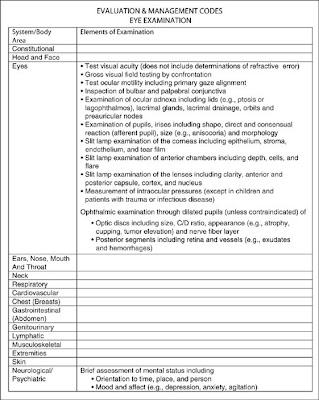New Patients. If your level is 4 or higher, you should probably be using E/M codes. If your level is 3 or lower, you should be using Eye Codes unless you fail to initiate a diagnostic and treatment program at the comprehensive eye code level. Then you will have to drop to 99203.
 • Consultations. If your adjective is moderate, level 4 or higher, the E/M consultation code should be used. If not, switch to the eye codes.
• Consultations. If your adjective is moderate, level 4 or higher, the E/M consultation code should be used. If not, switch to the eye codes.Return Office Visits:
92012 versus 99213. For return office visits for conditions requiring more frequent visits the choice is often between CPT codes 99213 and 92012. An error was made in the relative value units calculation in 1998, and the erroneous calculation has been pretty much maintained. This has resulted in significantly higher reimbursement for code in 2009 — $9.38 in 2009 on a national average. Given the choice, the eye code pays better than the E/M code and can be used in most instances.
• 92014 vs. 99214. Code 92014 basically should be used when coding for comprehensive eye examinations and not for follow-up visits for serious disease.
Use 92014 for your follow-ups in which medical necessity dictates a comprehensive examination — such as a return in one year for cataract follow-up. The code is not intended to be used for frequent follow-up visits for serious pathological conditions.
Use 99214 when following serious diseases as long as your medical decision-making is moderate and you have the medical necessity to perform nine of the elements. This code has been a target of OIG investigations and you should be confident of your coding skills and chart documentation when using it.
• 99212. Most Medicare local coverage determinations for the eye codes mandate that for minimal services code 99212 be used — not 99213 or 92012. Quick check ups for conjunctivitis or healing corneal abrasions would fall into this category.










